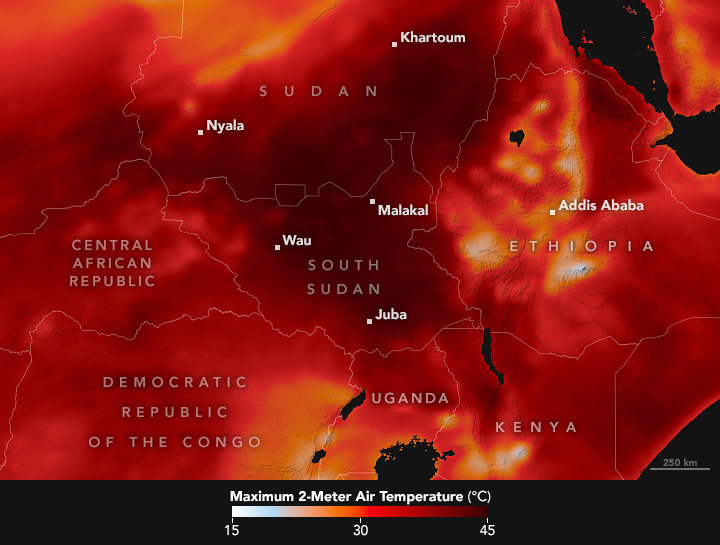
In March 2024, a heatwave scorched East Africa. The extreme heat forced government officials to resort to emergency safety measures including shuttering schools in South Sudan for two weeks.
Heat spread over the region in mid-March and was especially intense in South Sudan. On March 16, government officials ordered a temporary school closure due to forecasted temperatures between 41 and 45 degrees Celsius (106 and 113 degrees Fahrenheit), which were expected to linger for two weeks.
The oppressive heat in South Sudan rose above 37°C (99°F), the average high during the dry season. Some residents in the capital, Juba, endured the heat without electric fans because increased demand led to power cuts. According to news reports, incidents of death due to excessive heat were reported in the country.
The map above shows air temperatures across East Africa on March 18, 2024. The map was produced by combining satellite observations with temperatures predicted by a version of the Goddard Earth Observing System (GEOS) model, which uses meteorological observations and mathematical equations to represent physical processes in the atmosphere. Colors from white to red represent temperatures at about 2 meters (6.5 feet) above the ground at about 12:00 Universal Time. The darkest reds indicate temperatures of 45°C (113°F). Output from the GEOS model indicates that the highest temperature recorded in the region on March 18 was 45°C near the border of Sudan and South Sudan.
The heat wave is a continuation of unusually high temperatures recorded throughout the continent in February. In southern Africa (including Botswana, Namibia, Mozambique, South Africa, Zambia, and Zimbabwe) temperatures were 4 to 5°C above the February average, according to the World Meteorological Organization. In West Africa, the most severe heat occurred over five days in mid-February, when temperatures climbed above 40°C. An international team of scientists with World Weather Attribution analyzed the February heatwave and estimated that the event was 10 times more likely due to climate change.
On March 25, officials in South Sudan said temperatures were expected to drop in the coming days with the arrival of the rainy season. They called for schools to reopen on April 2.
NASA Earth Observatory image by Michala Garrison, using GEOS data from the Global Modeling and Assimilation Office at NASA GSFC. Story by Emily Cassidy.
Source link : https://earthobservatory.nasa.gov/images/152600/heat-wave-in-east-africa
Author :
Publish date : 2024-03-26 07:00:00
Copyright for syndicated content belongs to the linked Source.





